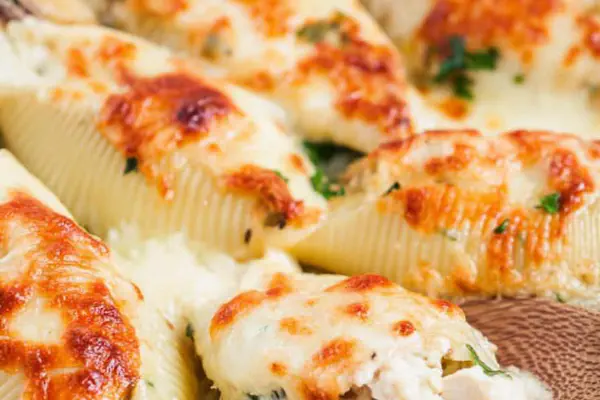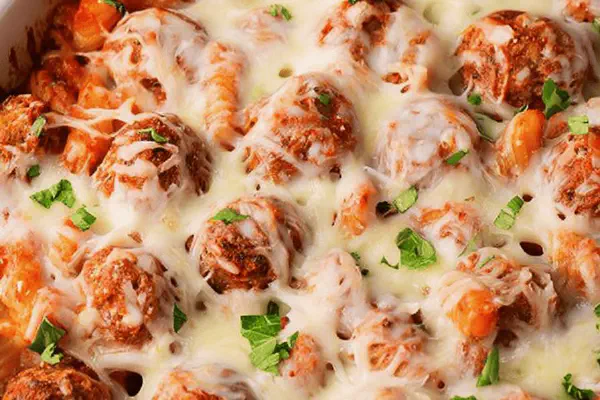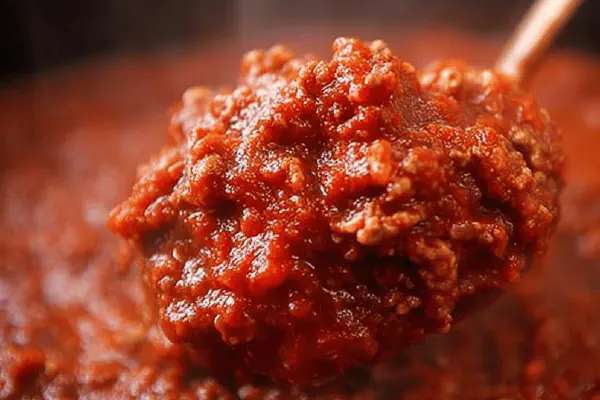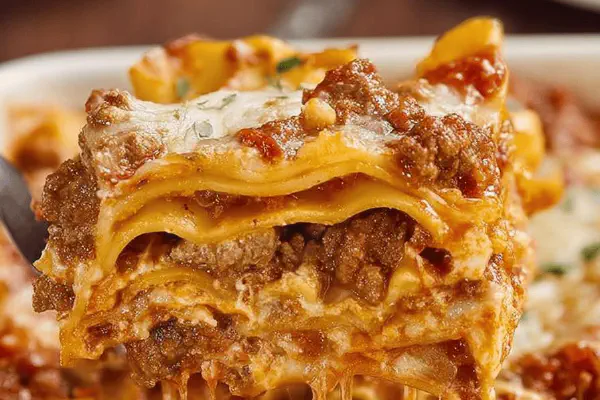Pepperoni Pizza Spaghetti Bake
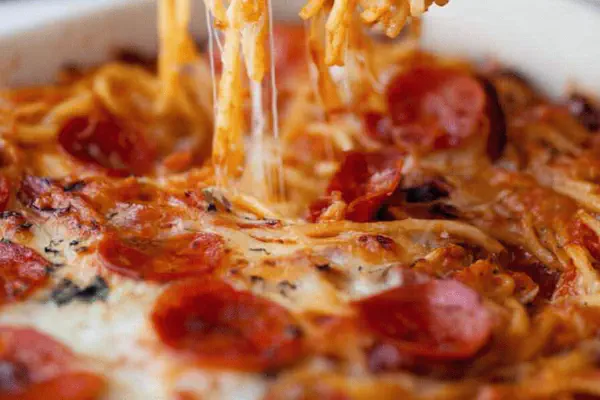
E
By Emma
Certified Culinary Professional
•
Recipe tested & approved
Noodles boiled just right then layered in a casserole; sauce spread thin over the bottom first. Cheese whispers between layers alongside pepperoni slices stacked generously. Baked until bubbling, the broiler hits the cheese with that golden glow — watch the pepperoni closely or it scorches fast. Blot out grease, serve hot. Familiar pizza flavors meet pasta comfort. Modest prep that yields layered, cheesy heat with crunchy pepperoni edges and saucy noodles in every forkful.
Prep:
15 min
Cook:
25 min
Total:
40 min
Servings:
6 servings
#Italian-American
#casserole
#baked pasta
#pepperoni
#comfort food
Imagine poking a fork into bubbling hot cheese, feeling resistance then gooey stretch, porky pepperoni edges crowned with crisp. Not your usual spaghetti dinner—layers rather than tossed. A casserole riff on pizza, but you don’t mix sauce with noodles beforehand, that’ll make the bake soggy, mushy. Sauce’s placement at bottom provides moisture steam. Learned from past tries: over-boiled noodles turn gluey mush here. Better al dente — pasta keeps structure through oven heat. Broiling’s crucial; it’s the golden crown, turning cheese snappy and pepperoni edges curling dark cherry red, not black burnt. A quick blotting trick saves that greasy slip-slide. You’ll see layered heat with pepperoni rich in every bite, cheese strings pulling, pasta firm yet yielding.
Ingredients
- 8 ounces spaghetti or linguine noodles
- 1 ½ cups pizza sauce or marinara sauce
- 2 cups shredded mozzarella cheese
- 30 slices pepperoni or substitute 8 ounces cooked Italian sausage, crumbled
- Optional herbs: oregano or basil for sprinkling
About the ingredients
For noodles, spaghetti’s classic, but linguine adds texture bite worth a try. Boil with just enough salt, mimics sea spray, boosts bland pasta’s life. Use pizza sauce over marinara for intense tomato flavor and spices; swap if aiming milder. Mozzarella’s key, whole-milk recommended for cream and melt — part-skim yields drier top. Pepperoni’s original meat here, but crumbled spicy Italian sausage offers warm crumble variations and less grease runoff. Herbs optional but fresh oregano or basil cuts richness, brightens. If you only have pre-shredded cheese, toss with powdered anti-caking agent to prevent clumps during layering. Drain noodles well—excess water ruins bake consistency. Keep layers modest; piling too thick traps moisture and dulls crispy top development. Use a shallow baking dish; too deep sacrifices browning.
Method
- Start with boiling noodles in salted water; follow package but shave off 1-2 minutes so al dente holds up during bake.
- Drain noodles thoroughly; no soggy pasta here, set aside in colander while prepping casserole.
- Lightly spread a thin layer of sauce covering bottom of a 9x13 baking dish — this keeps noodles from sticking and adds moisture.
- Add half the noodles in an even layer, sprinkle with half the mozzarella — don’t drown it, keep layers visible.
- Scatter half the pepperoni slices evenly, pushing some slightly into cheese to meld flavors.
- Repeat layering noodles, cheese, pepperoni until all used, finishing with cheese on top for browning focus.
- Place in preheated 350°F oven; bake about 25 minutes to heat through, sauce bubbling at edges – check early if your oven runs hot.
- Switch oven to broil on high for 3-5 minutes. Watch closely—pepperoni edges should crisp, cheese bubble dark gold, not blackened.
- Remove casserole carefully, use paper towels to blot pepperoni grease gently — excess oil dulls that melty cheese experience.
- Let sit 5 minutes before serving; cheese firms up slightly, cuts cleaner, layers settle.
- Optional: sprinkle dried oregano or chopped fresh basil over top for fresh lift.
Cooking tips
Timing’s a guideline; watch bubbling and cheese color over strict minutes. Pasta’s cooked al dente before assembly — that’s your baseline texture. Layering matters: sauce first, like a wet barrier prevents noodles sticking to dish and keeps moisture controlled. Cheese and pepperoni in thin layers; thick coating steam-traps and gets rubbery. Bake at 350° until heat makes sauce bubble at edges — signals internal hotness. Switch to broil for cheese caramelization and pepperoni edges curling lacy crisp. Broiling’s a staring contest; steam and smell help judge doneness. Too long means burnt pepperoni bitterness. Blot grease after broil with napkin—this cuts oil slick that weighs down flavors. Rest 5 minutes helps cheese firm up for cleaner slices and safer munching. Use oven mitts handling hot dish, stand clear from broiler heat to avoid burns. Follow these tips and watch each step’s visual and aroma cues, not just clocks.
Chef's notes
- 💡 Boil noodles just shy of al dente. Shaving 1-2 minutes prevents mush after oven heat. Pasta holds bite under sauce and cheese without turning gluey.
- 💡 Sauce layer bottom stops noodles sticking to dish and controls moisture. Spread thin. Thickness traps steam causing sogginess; thin barrier works best.
- 💡 Layer cheese and pepperoni thinly. Thick layers steam lock. Thin layers meld flavors better. Press pepperoni slightly into cheese for fusion under heat.
- 💡 Watch broiler step closely. Cheese bubbles golden, edges crisp dark cherry red. Too long burns pepperoni bitterness. Steam and smell tell doneness better than clock.
- 💡 After broil, blot grease with paper towels. Extra oil dulls melty cheese experience and drips messy. Blotting tightens texture without losing heat or flavor.
Common questions
Can I use other pasta shapes?
Yes, but less surface area changes bake texture. Linguine works well too, adds bite. Avoid super thick shapes, bakes uneven.
What if no pizza sauce?
Marinara sub fine but less spice and tomato punch. Adding a sprinkle of Italian seasoning helps mimic intensity lost.
Why soggy pasta?
Overboiled noodles soak excess water. Bake traps all moisture. Drain very well; dry noodles hold separation not glue. Layering thin helps.
How store leftovers?
Refrigerate airtight 3-4 days. Reheat covered to keep moist. Freeze in portioned containers, thaw overnight. Texture changes but flavor holds.
